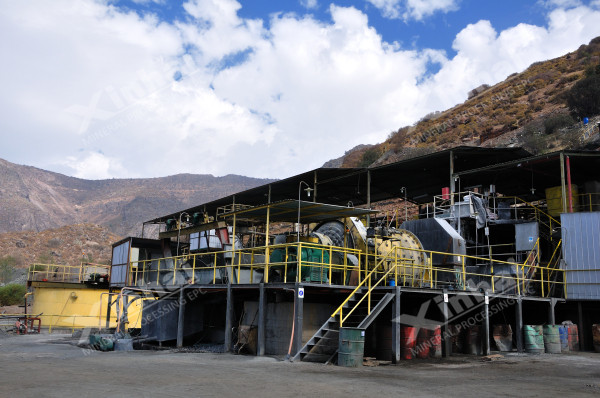In a copper ore processing plant, the first phase, the second phase, and the first phase of the second processing plant were commissioned in 1997, 2003, and 2007, respectively. By 2007, when the first phase of the second processing plant was commissioned, the daily processing capacity of copper ore in the plant had reached 15,000 tons. So, how is the ball milling equipment configured in this copper ore processing plant?

The copper ore in question is a large-scale copper ore with copper and iron as the main metal minerals. Chalcopyrite is the primary copper mineral, followed by bornite, with trace amounts of covellite and chrysocolla. The iron minerals consist mainly of magnetite, followed by hematite, goethite, and trace amounts of brown iron ore. The mineral composition is simple, with coarse-grained embedding of copper minerals and fine-grained embedding of iron minerals, providing good selectivity.
Based on the ore characteristics, the plant is designed with a process flow of three-stage crushing in a closed circuit, achieving a final particle size of -12 mm. The crushed ore products undergo two stages of continuous milling to a particle size of -0.074 mm, with 70% of the minerals, followed by one roughing, one scavenging, and two cleaning stages to obtain copper concentrate. The tailings from the copper selection process undergo one rough magnetic separation to obtain rough concentrate, which is then ground to a particle size of -0.074 mm with 92% fineness. Subsequently, two cleaning stages are performed to obtain iron concentrate. The dewatering of concentrates involves two stages of thickening and filtration, resulting in copper concentrate with 11% moisture and iron concentrate with 10% moisture.
Due to the good selectivity of the copper and iron minerals with coarse-grained embedding of copper minerals and fine-grained embedding of iron minerals, a flotation-magnetic process is adopted—rough grinding to float copper followed by fine grinding to select iron. This process aligns with the ore characteristics, avoiding over-crushing of copper minerals and losses due to mud formation. It facilitates the sequential recovery of copper and iron minerals according to the coarse and fine particle sizes, achieving optimal comprehensive utilization.
The milling and selection process in the plant is divided into three series, implemented in two phases. The first phase includes two series with a scale of 2,400 t/d. The second phase, or series 3, of the first plant is an expansion based on the first-phase project. Due to site limitations and the constraints of scale expansion, a single-stage closed-circuit milling process with a capacity of 3,000 t/d is adopted.
The second plant's first phase is designed for 4,000 t/d, and the milling and selection process is the same as the first plant's 1# and 2# series.
First Phase of the First Plant:
The first phase of the first plant has a capacity of 2,400 t/d, with two series of milling and selection processes. Series 1# uses two idle 3200×3100 ball mills (one MQG type and one MQY type), with an actual production capacity of up to 1,400 t/d. When the first phase is completed, the milling capacity can reach 2,600 t/d.
To match the milling capacity, series 1# for copper selection has four more flotation machine cells than series 2# (two roughing and two cleaning cells).
The first-stage milling machine is in a closed circuit with a high weir double spiral classifier, and the second-stage milling machine is in a closed circuit with a φ500 cyclone. The regrinding of iron concentrate uses an MQY2100×4500 overflow type mill in a closed circuit with a φ250 cyclone. To further improve the iron concentrate grade, a vertical pulse vibration magnetic separator (LMC-2570) and a high-frequency vibrating screen (GYX31-1207) are added to the iron selection circuit.
Series 2# uses two 2700×3600 ball mills (one MQG type and one MQY type).
Second Phase of the First Plant:
The second phase of the first plant, or series 3#, uses two MQY3600×4500 overflow type ball mills and an FX-600 cyclone to form a closed circuit.
To improve the concentrate grade, series 3# adds a MQY2100×3000 overflow type ball mill for further fine grinding of the product from the high-frequency vibrating screen.
These technical measures increase the iron concentrate grade from the original 61% to over 63%. Since the start of production, the first plant has gradually increased its production capacity to the level of 10,000 t/d through production optimization and technological improvements.
First Phase of the Second Plant:
The first phase of the second plant is designed for 4,000 t/d and uses two 3600×4500 ball mills (one MQG type and one MQY type).
For the flotation equipment selection, the second plant uses the domestically advanced KYF-40 large-scale flotation machine for rougher-scavenger flotation. This machine has significant advantages in terms of energy saving, reduced plant footprint, and operation and maintenance. Magnetic separation employs a vertical pulse vibration magnetic separator (LMC-2570) and a high-frequency vibrating screen (GYX31-1207) to improve the iron concentrate grade. The plant achieved its designed processing capacity after being put into production.
In practice, the plant has broken through the 5,300 t/d processing capacity through the use of scientific and reasonable precise ball filling technology and process technology transformation.
This article introduces the configuration scheme of the milling equipment in a 15,000 TPD copper ore processing plant, providing a reference and reference case for plant owners. In actual production, the beneficiation process and equipment selection should be determined based on the actual situation of each plant through beneficiation tests to improve beneficiation results, making our plants more energy-efficient, productive, and economically beneficial.